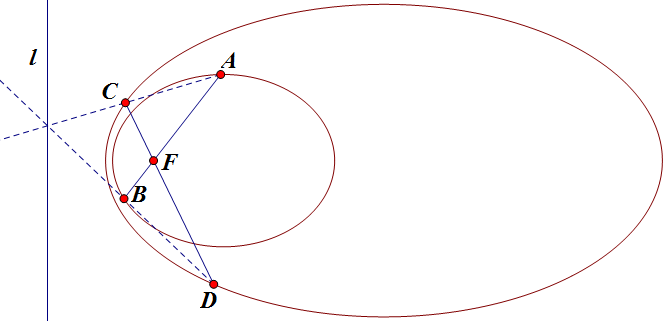|
|
Last edited by kuing 2025-3-30 15:33张角定理,是平面几何学的一个定理,指任意 `\triangle ABC` 中,`D` 是边 `BC`(包括端点)上的点,连接 `AD`,则
\[\frac{\sin\angle BAD}{AC}+\frac{\sin\angle CAD}{AB}=\frac{\sin\angle BAC}{AD},\]
其逆定理亦成立。
写成轮换对称的形式,即:若三点 `P_1`, `P_2`, `P_3` 共线,`O` 在直线外,则有
\[\frac{\sin\measuredangle P_1OP_2}{OP_3}+\frac{\sin\measuredangle P_2OP_3}{OP_1}+\frac{\sin\measuredangle P_3OP_1}{OP_2}=0.\]
由此即得极坐标下的两点式:设极坐标下两点 `A(\rho_1,\theta_1)`, `B(\rho_2,\theta_2)`,则直线 `AB` 的方程为
\[\frac{\sin(\theta_1-\theta_2)}\rho+\frac{\sin(\theta_2-\theta)}{\rho_1}+\frac{\sin(\theta-\theta_1)}{\rho_2}=0.\]
我不会无缘无故写这些,话说前两天研究某微信网友的一类问题时发现以下的:
命题:已知两圆锥曲线 `\Gamma_1`, `\Gamma_2` 有共同的焦点 `F` 及准线 `l`,`\Gamma_1` 上的弦 `AB` 过 `F`,`\Gamma_2` 上的弦 `CD` 过 `F`,则直线 `AC` 与 `BD` 的交点在 `l` 上。

此题利用上述两点式以及圆锥曲线的极坐标方程,证起来就计算量就不大。
证明:只需证明 `AC` 与 `l` 的交点与 `BD` 与 `l` 的交点是同一个点即可。
记焦准距为 `p`,建立极坐标系使 `F` 为原点且准线为 `\rho\cos\theta=-p`。
设 `\Gamma_1`, `\Gamma_2` 的离心率分别为 `e_1`, `e_2`,则可设 `A(\rho_1,\theta_1)`, `C(\rho_2,\theta_2)`,其中
\[\rho_1=\frac{e_1p}{1-e_1\cos\theta_1},~\rho_2=\frac{e_2p}{1-e_2\cos\theta_2},\]
根据上述两点式,可知直线 `AC` 的方程为
\[\frac{\sin(\theta_1-\theta_2)}\rho+\frac{\sin(\theta_2-\theta)(1-e_1\cos\theta_1)}{e_1p}+\frac{\sin(\theta-\theta_1)(1-e_2\cos\theta_2)}{e_2p}=0,\]
(注意别看错了 `\rho` 与 `p`)整理为
\[\frac{\sin(\theta_1-\theta_2)}\rho+\frac{\sin(\theta_2-\theta)}{e_1p}+\frac{\sin(\theta-\theta_1)}{e_2p}-\frac{\sin(\theta_2-\theta)\cos\theta_1+\sin(\theta-\theta_1)\cos\theta_2}p=0,\]
易证恒等式 `\sum\sin(x-y)\cos z=0`,则 `\sin(\theta_2-\theta)\cos\theta_1+\sin(\theta-\theta_1)\cos\theta_2=-\sin(\theta_1-\theta_2)\cos\theta`,所以 `AC` 的方程最终化简为
\[\sin(\theta_1-\theta_2)\left(\frac p\rho+\cos\theta\right)+\frac{\sin(\theta_2-\theta)}{e_1}+\frac{\sin(\theta-\theta_1)}{e_2}=0,\]
而准线 `l` 的方程为
\[\rho\cos\theta=-p,\]
联立以上两方程,后者代入前者消去 `\rho`,恰好第一项就没了,得到
\[\frac{\sin(\theta_2-\theta)}{e_1}+\frac{\sin(\theta-\theta_1)}{e_2}=0,\]
去分母展开即
\begin{gather*}
e_1\sin(\theta-\theta_1)=e_2\sin(\theta-\theta_2),\\
e_1(\sin\theta\cos\theta_1-\cos\theta\sin\theta_1)=e_2(\sin\theta\cos\theta_2-\cos\theta\sin\theta_2),\\
e_1(\tan\theta\cos\theta_1-\sin\theta_1)=e_2(\tan\theta\cos\theta_2-\sin\theta_2),\\
\tan\theta=\frac{e_1\sin\theta_1-e_2\sin\theta_2}{e_1\cos\theta_1-e_2\cos\theta_2},\quad(*)
\end{gather*}
这便是 `AC` 与 `l` 的交点的极角 `\theta` 满足的等式。
至于 `BD`,显然 `B`, `D` 的极角分别就是 `A`, `C` 的 `\theta_1`, `\theta_2` 变成 `\theta_1+\pi`, `\theta_2+\pi`,再看式 (*),显然 `(\theta_1,\theta_2)\to(\theta_1+\pi,\theta_2+\pi)` 后右边的值不变,这就说明了 `BD` 与 `l` 的交点与 `AC` 与 `l` 的交点是同一点,即命题得证。
|
Rate
-
View Rating Log
|